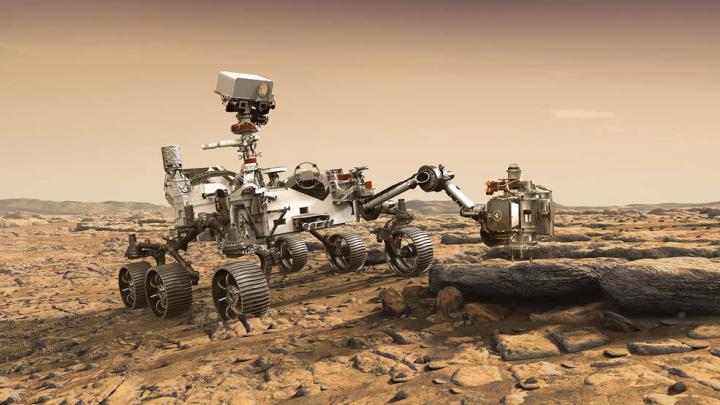The first spacecraft to collect Martian rocks for eventual return to Earthwill explore Jezero crater, NASA announced on 19 November. Jezero is a 45-kilometre-wide crater that was once filled with water, where Martian life could have thrived.
“Getting samples from this unique area will revolutionize how we think about Mars and its ability to harbour life,” says Thomas Zurbuchen, NASA’s associate administrator for science, who chose Jezero over three other finalists.
Still undecided is whether the rover would embark on a long drive to a second site after it finishes surveying Jezero. Some scientists want the rover to roll 28 kilometres to a location dubbed Midway, where it could sample some of the most ancient rocks known on the red planet.
Either way, the 2020 rover will set the direction of NASA’s Mars programme for years to come, says Lori Glaze, acting director of the agency’s planetary-sciences division in Washington DC.
Rocking out
Jezero was formed billions of year ago by a meteorite impact. At one point, water filled it to a depth of about 250 metres, and then flowed out — leaving behind sediments that could contain a record of life, if any ever existed there. “You see a canyon coming in and depositing the sediment,” says Kenneth Farley, the mission’s project scientist. “That is a major attraction.”
Jezero is also home to carbonate rocks, whose chemistry could reveal how the lake’s water and the Martian atmosphere interacted in the distant past, Farley says. And a wider variety of rocks found upstream could have been swept into the crater, where the rover could study them as well.
The varied geology of Jezero and its surroundings helped Jezero to beat out other potential destinations for the 2020 rover. They include Northeast Syrtis, which contains some of the oldest rocks on Mars, and Columbia Hills, which the Spirit rover explored between 2004 and 2011.
The US$2.4-billion rover is slated to launch in July 2020 and land on Mars in February 2021. It will carry 37 sample tubes and 5 spares, which it will fill using its robotic arm — an attachment designed to drill long, slender cylinders of Martian rock. The rover will collect a variety of samples as it explores the red planet, and eventually set them down for a future mission to retrieve.
NASA has not yet developed a detailed plan for transporting the samples back to Earth. Zurbuchen says that it hopes to send a mission to Mars in the late 2020s to retrieve the rocks, and return them to Earth in the early 2030s.
Quelle: nature
+++
NASA’s next Mars rover will land in Jezero crater, which once hosted a lake and a river delta
Update: NASA today announced the destination for its next Mars rover, due for launch in 2020. The agency said it would send the rover to the 50-kilometer-wide Jezero crater, which billions of years ago harbored a lake that half filled the 500-meter-deep basin. The crater also contains within its rim a fossilized river delta, the sediments from a river that spilled into the crater—a promising place to search for evidence of past life. “Getting samples from this unique area will revolutionize how we think about Mars and its ability to harbor life,” Thomas Zurbuchen, NASA’s associate administrator for science in Washington, D.C., said in a press conference.
Mars scientists also wanted to visit a nearby site, called Northeast Syrtis, which contains rocks formed in the presence of mineral springs. So NASA dangled the possibility of a two-for-one special—that after visiting Jezero, the rover might climb out of the crater and travel 25 kilometers to Midway, a site that contains many of the same rocks as Northeast Syrtis. Zurbuchen said the possibility of an extended mission to Midway is not ruled out, but he wants the team to focus on Jezero crater for now. “Come the time, we want to talk about it,” he said. “But at this moment we’re focusing on the prime mission.”
The 2020 rover will be tasked with gathering and caching rock and soil samples for eventual return to Earth by subsequent missions. At a workshop attended by hundreds of Mars scientists a month ago, Jezero was one of the leading landing sites. Here is our previous story from 10 October:
Sometimes, a problem really can be solved by meeting halfway. For the past 4 years, planetary scientists have wrestled over where to send NASA's next Mars rover, a $2.5 billion machine to be launched in 2020 that will collect rock samples for eventual return to Earth. Next week, nearly 200 Mars scientists will gather for a final landing site workshop in Glendale, California, where they will debate the merits of the three candidate sites that rose to the top of previous discussions. Two, Jezero and Northeast Syrtis, hold evidence of a fossilized river delta and mineral springs, both promising environments for ancient life. Scientists yearn to visit both, but they are 37 kilometers apart—much farther than any martian rover has traveled except Opportunity.
Now, the Mars 2020 science team is injecting a compromise site, called Midway, into the mix. John Grant, a planetary scientist at the Smithsonian Institution's Center for Earth and Planetary Studies at the National Air and Space Museum in Washington, D.C., who co-leads the landing site workshops, says the team wanted to know whether a rover might be able to study the terrains found at Jezero and Northeast Syrtis by landing somewhere in the middle.
So far, the answer appears to be yes. The Mars 2020 rover borrows much from the design of the Curiosity rover that has been exploring another Mars site for 6 years. But it includes advances such as a belly-mounted camera that will help it avoid landing hazards during its harrowing descent to the surface. This capability allowed scientists to consider Midway, just 25 kilometers from Jezero and close enough to drive there. At the same time, Midway's rocks resemble those of Northeast Syrtis, says Bethany Ehlmann, a planetary scientist at the California Institute of Technology (Caltech) in Pasadena and member of the Mars 2020 science team.
Midway and Northeast Syrtis both hail from a time, some 4 billion years ago, when Mars was warmer and wetter. Surveys from orbit suggest the sites harbor rocks that formed underground in the presence of water and iron, a potential food for microbes. The rocks, exposed on the flanks of mesas, include a layer of carbonate deposits that many scientists believe were formed by underground mineral springs. Sheltered from a harsh surface environment, these springs would have been hospitable to life, Ehlmann says. "We should go where the action was."
Nearby Jezero crater has its own allure, etched on the surface: a fossilized river delta. Nearly 4 billion years ago, water spilled into the crater, creating the delta. "It's right there," says Ray Arvidson, a planetary geologist at Washington University in St. Louis, Missouri. "It's beautiful." Geologists know deltas concentrate and preserve the remnants of life; they can see that on Earth in offshore deposits of oil—itself preserved organic matter—fed by deltas like the Mississippi's. New work to be presented at the workshop by Briony Horgan, a planetary scientist at Purdue University in West Lafayette, Indiana, will show that Jezero crater has a bathtub ring of carbonate—a strong sign that it once contained a lake. On Earth, such layers are often home to stromatolites, cauliflowerlike minerals created by ancient microbial life.
Right now, the Mars 2020 team favors landing at Jezero and driving uphill to Midway, says Matt Golombek, a planetary scientist at NASA's Jet Propulsion Lab (JPL) in Pasadena, and the other workshop co-leader. For the past year, the team has scoured potential routes between the two. "We haven't identified any deal-breakers," says Ken Farley, the mission's project scientist and a Caltech geologist. The rover's advanced autonomous driving should allow it to cover more ground than Curiosity, which often stops to plan routes. Even so, the path from Jezero to Midway would take nearly 2 years, Farley says. That means the rover could explore only one site during its primary 2-year mission, when it must drill and store 20 rock cores, to be picked up by future sample return missions. Exploration of the second site would have to come during an extended mission, after the rover's warranty expires. "The further away you land from your gold mine, the higher the risk you might not get there," Arvidson says.
Jezero and Northeast Syrtis, two attractive landing sites for NASA's Mars 2020 rover, are close to each other. A new landing site, Midway, might allow the rover to study rocks from both terrains.
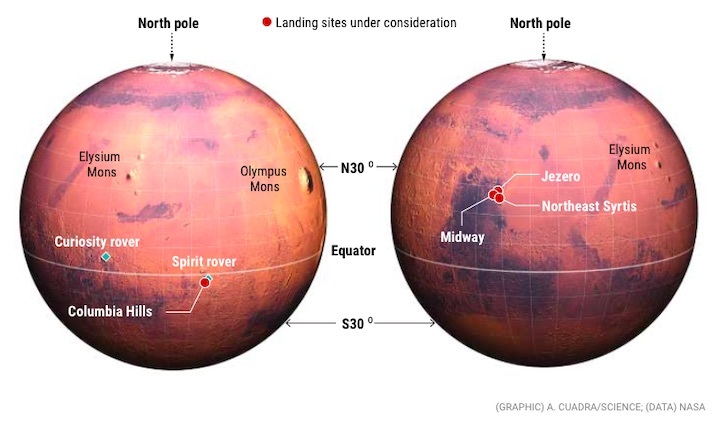
Left out of those plans is the last leading candidate site: Columbia Hills. "I have a sense there's a hill to climb," says the site's chief advocate, Steven Ruff, a planetary scientist at Arizona State University in Tempe. "I'll go in with a lot of questions of whether they can make that drive between Midway and Jezero." Columbia Hills sits within the large Gusev crater that the Spirit rover explored from 2004 to 2010. Driving backward while dragging a bad front wheel, Spirit gouged a trench that revealed opaline silica, a mineral that on Earth is a sure sign of life-supporting hot springs. Ruff has even proposed that the martian silica deposits are stromatolites.
The engineers building Mars 2020 will be glad to settle on a destination, says Matt Wallace, the rover's deputy project manager at JPL. The lab's clean room is starting to fill up. The "sky crane" that will lower the rover to the surface is done. The spacecraft that will shepherd the rover to Mars is nearly complete—it just needs a heat shield, which is being rebuilt after testing revealed a crack. Several weeks ago, the chassis of the rover arrived and is now being filled with computers, batteries, and other electronics. Assembly of its complex drilling and sample storage system is underway, with other scientific instruments due by the end of February. "This is the mad scramble," Farley adds. "It is full bore get it done, get it done now."
At the workshop's end, scientists will vote on the candidates, followed by a closed-door meeting of the rover team to make a final choice. Engineers have deemed the sites safe for landing, Golombek adds, so it will come down to the science. The team's recommendation won't be the final word—the choice is ultimately up to NASA science chief Thomas Zurbuchen. But expect a decision within the next few months, if not sooner.
Quelle: Science
----
Update: 6.12.2018
.
Mars 2020 rover mission camera system ‘Mastcam-Z’ testing begins at ASU
Arizona State University research technician and Mars 2020 Mastcam-Z calibration engineer Andy Winhold waited patiently on the loading dock of ASU’s Interdisciplinary Science and Technology Building IV in anticipation of the arrival of a very special delivery.
On board the delivery truck was precious cargo from Malin Space Science Systems, a test model of “Mastcam-Z,” the mast-mounted camera system for NASA’s Mars 2020 rover mission.
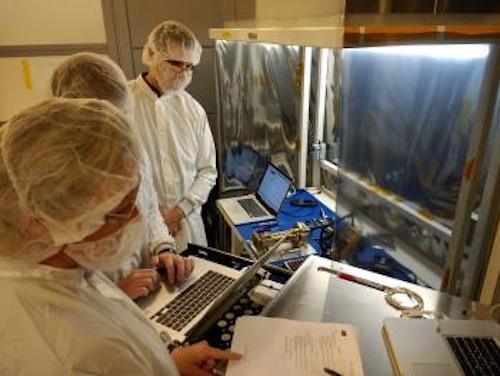
The Mastcam-Z team tests the engineering model in ASU’s cleanrooms.
Mastcam-Z is being designed, built and tested under the direction of principal investigator Jim Bell, of ASU’s School of Earth and Space Exploration. The dual camera system can zoom in (hence the ‘Z’ in “’Mastcam-Z’), focus and take 3D pictures and panoramas at a variety of scales. This will allow the Mars 2020 rover to provide a detailed examination of both close and distant objects.
The test model that arrived on the Tempe campus in November, otherwise known as an engineering qualification model or EQM, is an important step in designing and building instruments for space. These models not only serve as a way to run the instruments through the rigors of launch and functionality in space, they also serve as a way for the instrument team to evaluate the design and testing plans before the final cameras are fully assembled.
Testing the Mastcam-Z engineering model
The engineering model essentially allows the team to do a "dry run" through the complete design and build process of the instrument before the final versions of the cameras are complete.
“Parts may take longer to build than expected, a certain assembly step may be more difficult than initially thought or resources from third parties could become scarce on short notice,” Winhold said. “These are all things we can learn about and prepare for in advance using the engineering model.”
The team first verifies that the test instrument operates correctly in terms of parts, power consumption and software. They also use the model to ensure the instrument meets mission requirements in terms of functionality, size and weight. “For Mastcam-Z, one of the primary interests with the engineering model was evaluating the instrument’s ability to change focal length — or zoom,” Winhold said.
Specifically, the team tested the engineering model in the thermal vacuum chamber, located in ASU’s Interdisciplinary Science and Technology Building IV, to confirm that their support equipment was designed appropriately and allowed the camera to be placed securely in the chamber and view out the chamber's window clearly. They also timed the tests so they knew how long testing the actual cameras will take, and they tested the IT network's ability to share data quickly between people inside the cleanroom and other support team members outside of the room and around the world.
Winhold describes his role on the mission as similar to someone playing the game "Operation," where the patient is the Mastcam-Z cameras and the tweezers are the support pieces.
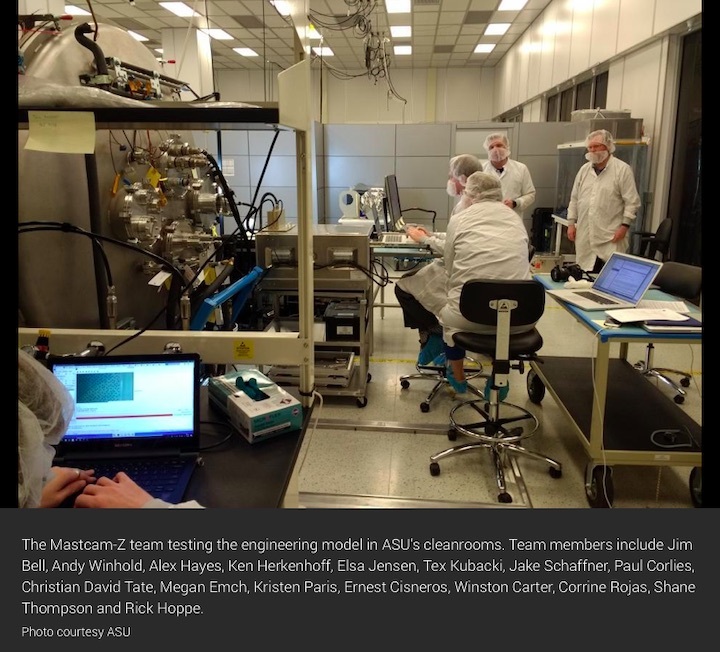
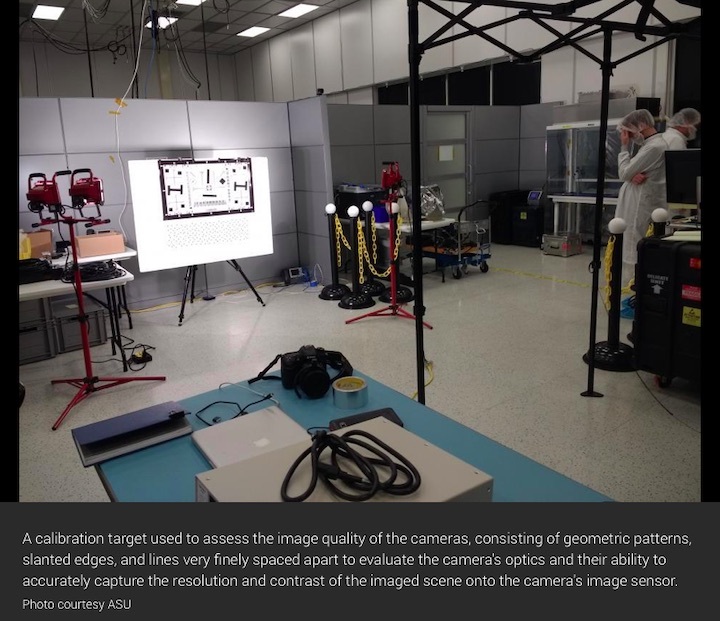

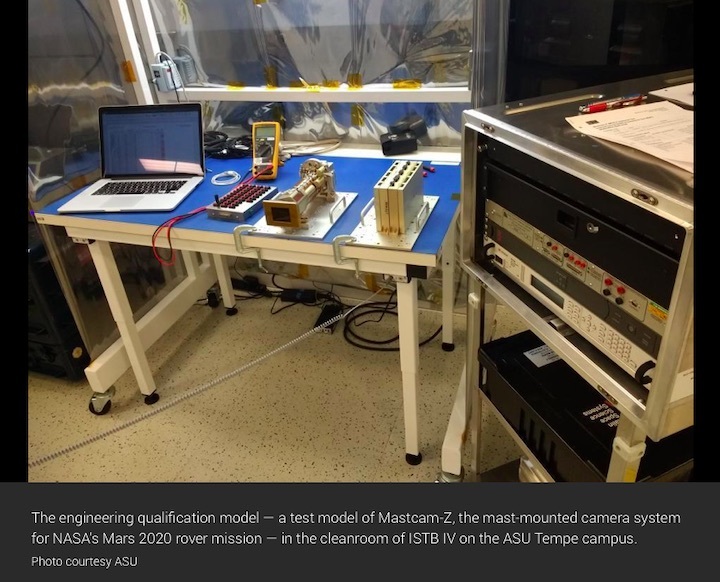
“But in my case,” said Winhold, “I'm only shown pictures of the board game, and based on those pictures I need to design and create the best tweezers for removing ailments without hurting the patient.”
And according to the team, the testing has been a success so far.
“We had a few hiccups we worked around, like cables not being long enough, not understanding best communication procedures, that sort of thing; but nothing truly unexpected,” Winhold said. “That's exactly how we like things. In testing equipment that will be going to space, a boring day that goes according to procedure is a good one.”
Next steps for the Mastcam-Z team
In December, the actual Mastcam-Z flight cameras will arrive on the ASU Tempe campus for testing. They will then be delivered to NASA's Jet Propulsion Laboratory and installed on the Mars 2020 rover, which will launch in summer 2020, landing on Mars in February 2021. The mission is expected to last at least one Mars year (687 Earth days).
“The tests we ran on the engineering unit at ASU are almost identical to the tests we'll be running on the actual cameras when they arrive,” Winhold said.
Once the instrument is finalized and installed in the Mars 2020 rover, the engineering model continues to have a purpose.
“Largely it is considered a ‘flight spare’ and will be a back-up unit should something happen to the flight cameras before launch,” Winhold explained. “Once the rover launches in the summer of 2020 we won't be able to do any hands-on interaction with the flight cameras, though, so we’ll have the engineering model as a reference for possible problem solving and as a reference for subsequent rover missions.”
About Mastcam-Z
The cameras weigh about 8.8 pounds and will produce images of color quality similar to that of a consumer digital HD camera (2 megapixels). The cameras will help other Mars 2020 experiments on the rover by looking at the whole landscape and identifying rocks and soil (regolith) that deserve a closer look by other instruments. They will also spot important rocks for the rover to sample and cache on the surface of Mars, for eventual return (by a future mission) to Earth.
Mastcam-Z's purpose is to take high resolution panoramic color and 3D images of the Martian surface and features in the atmosphere with a zoom lens to magnify distant targets. It will be mounted on the Mars 2020 rover mast at the eye level of a 6-foot-5-inch person. The two cameras are separated by 9.5 inches to provide stereo vision. These cameras, with their all-seeing sharp vision, will provide images for science team members to pick out the best rocks, to hunt for evidence of past habitability recorded in the geology and texture of the landscape, and to look for signs of past water on Mars.
Mastcam-Z’s principal investigator is Professor Jim Bell of the School of Earth and Space Exploration. The deputy principal investigator is Dr. Justin Maki of NASA's Jet Propulsion Laboratory, the Planetary Society serves as the instrument’s education and public outreach partner, and the prime subcontractor for instrument development is Malin Space Science Systems, Inc.
NASA's Mars 2020 rover mission
The Mars 2020 rover mission is part of NASA's Mars Exploration Program, a long-term effort of robotic exploration of the Red Planet. The Mars 2020 mission addresses high-priority science goals for Mars exploration, including key questions about the potential for life on Mars. The mission also seeks to gather knowledge and to demonstrate technologies that address the challenges of future human expeditions to Mars. These include testing a method for producing oxygen from the Martian atmosphere, identifying other resources (such as subsurface water), improving landing techniques, and characterizing weather, dust, and other potential environmental conditions that could affect future astronauts living and working on Mars.
Quelle: Arizona State University
----
Update: 21.03.2019
.
NASA's Mars 2020 Rover Is Put to the Test

In a little more than seven minutes in the early afternoon of Feb. 18, 2021, NASA's Mars 2020 rover will execute about 27,000 actions and calculations as it speeds through the hazardous transition from the edge of space to Mars' Jezero Crater. While that will be the first time the wheels of the 2,314-pound (1,050-kilogram) rover touch the Red Planet, the vehicle's network of processors, sensors and transmitters will, by then, have successfully simulated touchdown at Jezero many times before.
"We first landed on Jezero Crater on Jan. 23rd," said Heather Bottom, systems engineer for the Mars 2020 mission at the Jet Propulsion Laboratory in Pasadena, California. "And the rover successfully landed again on Mars two days later."
Bottom was the test lead for Systems Test 1, or ST1, the Mars 2020 engineering team's first opportunity to take the major components of the Mars 2020 mission for a test drive. Over two weeks in January, Bottom and 71 other engineers and technicians assigned to the 2020 mission took over the High Bay 1 cleanroom in JPL's Spacecraft Assembly Facility to put the software and electrical systems aboard the mission's cruise, entry capsule, descent stage and rover through their paces.
"ST1 was a massive undertaking," said Bottom. "It was our first chance to exercise the flight software we will fly on 2020 with the actual spacecraft components that will be heading to Mars - and make sure they not only operate as expected, but also interact with each other as expected."
The heritage for Mars 2020's software goes back to the Mars Exploration Rovers (Spirit and Opportunity) and the Curiosity rover that has been exploring Mars' Gale Crater since 2012. But 2020 is a different mission with a different rover, a different set of science instruments and a different destination on Mars. Its software has to be tailored accordingly.
Work began in earnest on the flight software in 2013. It was coded, recoded, analyzed and tested on computer workstations and laptops. Later, the flight software matriculated to spacecraft testbeds where it was exposed to computers, sensors and other electronic components customized to imitate the flight hardware that will launch with the mission in 2020.
"Virtual workstations and testbeds are an important part of the process," said Bottom. "But the tens of thousands of individual components that make up the electronics of this mission are not all going to act, or react, exactly like a testbed. Seeing the flight software and the actual flight hardware working together is the best way to build confidence in our processes. Test like you fly."
Making the Grade
On the day before ST1 began, the High Bay 1 cleanroom was hopping with "bunny suit"-clad engineers and technicians assembling, inspecting and testing the mission's hardware. The next day, Wednesday, Jan. 16, the room was eerily quiet. The majority of workers had been replaced by two technicians there to monitor the flight test hardware. Lines of electrical cabling - "umbilicals" - were added to provide data and power to the spacecraft's cruise stage, back shell, descent stage and rover chassis, which have yet to be stacked together. The ground to in-flight spacecraft (and in-flight spacecraft to ground) communications were handled by X-band radio transmission, just like they would be during the trip to Mars.
ST1 began with commands to energize the spacecraft's electrical components and set up thermal, power and telecom configurations. While all the spacecraft components remained in the cleanroom, Bottom and her team had them thinking they were sitting on top of an Atlas 541 rocket 190 feet (58 meters) above Launch Complex 41 at Cape Canaveral on July 17, 2020, waiting to be shot into space.
Next, they focused on another part of cruise before testing the landing sequence. Then they did it all over again.
After a successful launch, they time jumped 40 days ahead to simulate deep space cruise. How would the software and hardware interact when they had to perform navigation fixes and trajectory correction maneuvers? And how would they work when simulated events didn't go as planned? The team looked for answers on the operators' computer screens in the test operations room beside the cleanroom.
"From the test operations room, you could look out the windows onto the cleanroom floor and clearly see the flight hardware," said Bottom. "Nothing was visibly moving, but underneath the outer structure, there were flight computers swapping sides, radios sending and receiving transmissions, fuel valves moving in and out, subsystems being energized and later turned off, and electrical signals being sent to nonexistent pyrotechnic devices. There was a lot going on in there."
On Jan. 30, the Mars 2020 test team was able to close their 1,000-plus page book of procedures for ST1. They went two-for-two on Mars landings. They also launchedfour times, performed deep space navigation, executed several trajectory correction maneuvers and even tested a few in-flight off-nominal situations.This first evaluation of flight hardware and software, over a year in the making, had been a thorough success, demonstrating where things excelled and where they could be improved. When these new changes have been investigated on both a virtual workstation and in the testbed, they will have their chance to "fly" in one of the many other systems tests planned for Mars 2020.
"One of the future scenario tests will place the rover inside a thermal chamber and simulate being on the surface. It will step through mission critical activities at some very low Mars surface temperatures," said Bottom. "Both literally and figuratively it will be a very cool test."
The Mars 2020 Project at JPL manages rover development for NASA's Science Mission Directorate. NASA's Launch Services Program, based at the agency's Kennedy Space Center in Florida, is responsible for launch management. Mars 2020 will launch from Cape Canaveral Air Force Station in Florida.
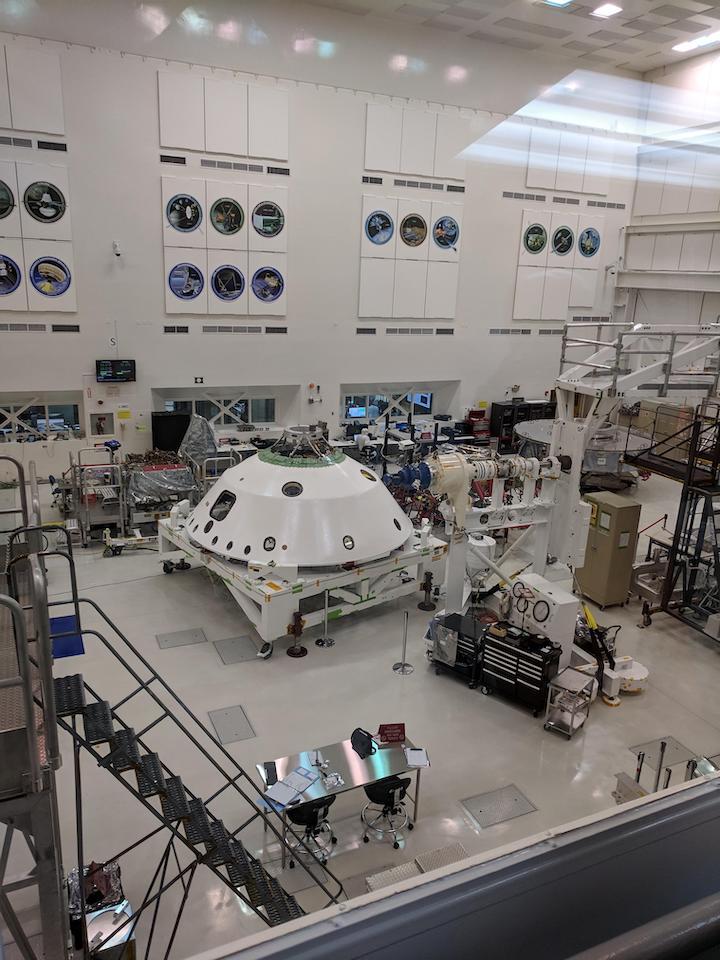
Quelle: NASA
----
Update: 14.04.2019
.
Taking Mars 2020 Integration Head-on
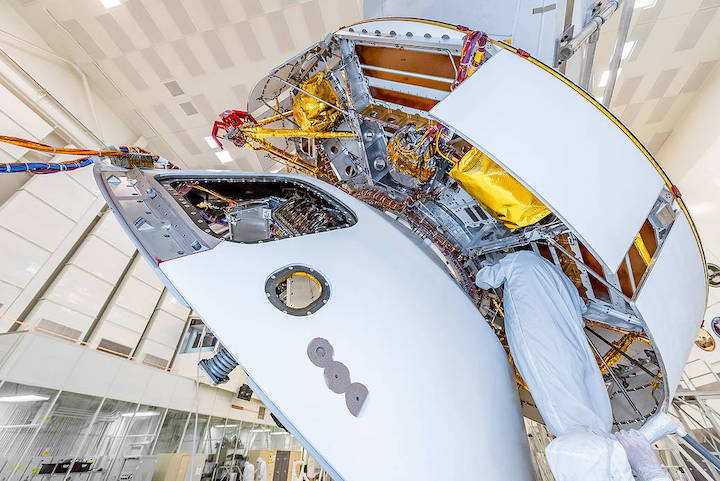
A member of NASA's Mars 2020 project checks connections between the spacecraft's back shell and cruise stage. The image was taken on March 26, 2019, in the Spacecraft Assembly Facility's High Bay 1 clean room at NASA's Jet Propulsion Laboratory, in Pasadena, California.
During the mission's voyage to Mars, the cruise stage houses the hardware that steers and provides power to the spacecraft. The back shell, along with the heatshield (not pictured), protects the 2020 rover and the sky crane landing system during Mars atmospheric entry.
JPL will build and manage operations of the Mars 2020 rover for the NASA Science Mission Directorate at the agency's headquarters in Washington.
Quelle: NASA
----
Update: 22.04.2019
.
Things Are Stacking Up for NASA's Mars 2020 Spacecraft
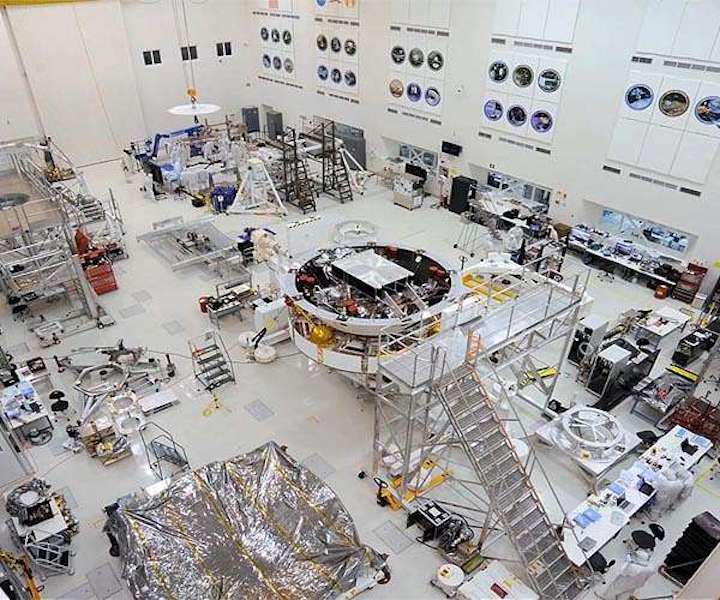
For the past few months, the clean room floor in High Bay 1 at NASA's Jet Propulsion Laboratory in Pasadena, California, has been covered in parts, components and test equipment for the Mars 2020 spacecraft, scheduled for launch toward the Red Planet in July of 2020. But over the past few weeks, some of these components - the spacecraft-rocket-laden landing system and even the stand-in for the rover (christened "surrogate-rover") - have seemingly disappeared.
In reality, they are still there, tucked neatly into the entry capsule, as they will be when it's time for launch. The procedure is known as vehicle stacking and involves a hyper-detailed plan for what goes where and when.
"One of our main jobs is to make sure the rover and all the hardware that is required to get the rover from here on Earth to the surface of Mars fits inside the payload fairing of an Atlas V rocket, which gives us about 15 feet [5 meters] of width to work with," said David Gruel, assembly, test and launch operations (ATLO) manager for Mars 2020 at JPL.
The first step is to place the rocket-powered descent stage on top of the surrogate rover (the real rover is being integrated and tested in tandem with the spacecraft stack). Then, when all the holes line up and everything is attached, checked and re-checked again, the back shell is lowered over them via gantry crane.
"That crane has lifted almost every spacecraft that's come through JPL since Mariner," said Gruel. "To safely lift the large pieces of the Mars 2020 spacecraft, we utilize a dozen technicians and engineers."
After the back shell is in place and everything is determined to be fitting properly, the team puts on the parachute nose cone, which protects the parachute during atmospheric entry, followed by the massive doughnut-shaped cruise stage, which will power the Mars 2020 spacecraft on its seven-month voyage to the Red Planet.
Then the vehicle stack is turned on its side so technicians and engineers have access to the mating points between the cruise and descent stages to make connections. The stack is then returned to its original position (cruise stage on top) so the heat shield can be raised into position and attached.
"Stacking is an important milestone in mission development, because as good as our computer models are, we still need to put it together to show that the bolt holes line up and everything fits together," said Gruel.
"It is a great feeling for the entire project when we see the stack sitting there waiting to go for the next part of its journey, which will eventually lead to a launch pad at Cape Canaveral in July of next year."
After three weeks, stacking is finished on April 3, and the spacecraft is transported to JPL's Environmental Test Facility to undergo acoustic testing. During this testing the stack will be bombarded with a thundering wall of sound designed to imitate the sound waves generated during launch.
Then, after a check to make sure no bolts have rattled loose or attachment points have become unstuck, the stack heads to the thermal vacuum chamber for a week-long test that simulates the harsh environment of space to assess how the Mars-bound craft and its instruments operate under flight-like conditions.
"Nothing is static with this mission," said Gruel. "After the acoustic and thermal vac tests, the stacked spacecraft is returned to the assembly building for de-stack, then more testing and more work. Until the hold-down bolts on the Atlas rocket blow and our rover is headed to Mars in July of 2020, there is almost always something being assembled, tested or modified."
The Mars 2020 rover will conduct geological assessments of its landing site on Mars, determine the habitability of the environment, search for signs of ancient Martian life, and assess natural resources and hazards for future human explorers.
Scientists will use the instruments aboard the rover to identify and collect samples of rock and soil, encase them in sealed tubes and leave them on the planet's surface for potential return to Earth on a future Mars mission.
Quelle: SD
